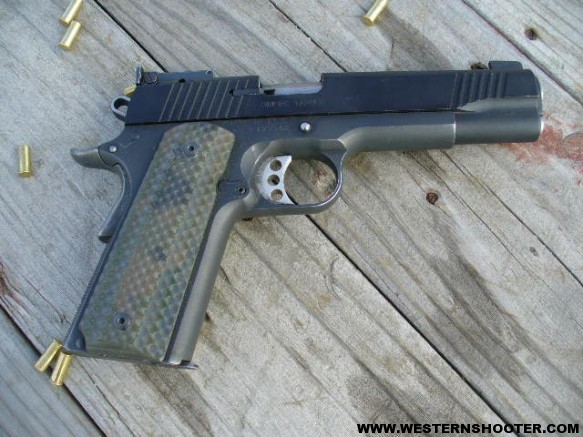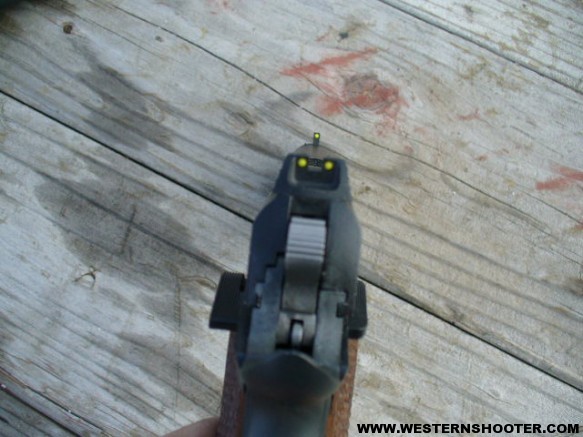At the shot show this winter I was able to spend some time with German Sport Guns (GSG) new 1911-22. ATI has been importing these and other GSG offerings over the past few years. My last experience with GSG was with their GSG-5, which is a highly reliable and accurate rendering of the famous HK MP5 series of weapons. Since the GSG-5 was introduced, they have followed with an AK-47 variant in .22 long rifle, and now a 1911 chambered in .22 long rifle.
Over the past 15 years I have had some experience with 1911’s and .22 conversion kits, and my impressions were not favorable. The few times I was able to test the conversion kits were nothing short of disappointment. They were picky about ammunition choices. Bulk ammo rarely cycled properly. CCI mini mag’s worked better, but the high cost of this ammo was enough to keep me from buying a conversion kit.
As fate would have it, ATI sent me a GSG-1911-22 this summer for evaluation. Fate also decided that if one is good, two is better. A very short time after the GSG 1911 arrived, I wound up trading for a Kimber Custom .45 1911 with a Kimber .22 conversion kit included. I soon realized the opportunity to test the guns against each other.
The GSG 1911 has a retail price of $359, but the street price is usually $300 to $320. The Kimber and conversion kit was used, but has a value of around $900.00. The conversion kit runs around $329 at most retailers. Both the GSG and the Kimber conversion kit comes with 10 round magazines.
Since both the GSG 1911 (complete gun) and the Kimber conversion kit (barrel and slide only-you supply the 1911 frame) cost about the same, it is evident that the GSG 1911 is the far better value. The Kimber would have to be far more reliable and accurate to beat the value of the GSG.

Fit, Finish and First Impressions
The GSG arrived with one 10 round magazine, a cleaning tool, and a different height front sites. It had an ambidextrous safety, which is a nice touch. The safety, magazine release and take down pin were in the typical 1911 locations. I did notice that an allen wrench was needed for disassembly, which is not needed on a typical 1911. The slide was smooth, the controls were tight, and the magazine insertion and removal was slick. The GSG can be had with plastic or wood grips, the version I was testing had the wood. These grips looked good, the checkering was consistent and the finish was of good quality. After my very positive experience with the GSG-5, I was expecting the 1911 to be of similar quality. The parkerizing was a little heavy and although appeared to be durable, it also gave off the feeling of heavy paint rather than parkerizing. My overall first impression was that it was a quality made handgun.

The Kimber 1911 conversion kit had a 10 round magazine, and an adjustable rear sight. It was easy to install on the .45 frame, as it used the same take down pin. In fact, the take down process was identical to a standard 1911. The fit and finish was good, and the slide slid smoothly back and forth on the frame. The adjustable rear sight was a welcome addition, something I wish the GSG 1911 was equipped with. It was slightly heavier than the GSG, which was expected because it also has to have the strength as a .45 ACP firing pistol. The Kimber was nicely parkerized.
Reliability and Accuracy
Shooting the two for reliability proved to be a long process. I was interested to see just how many rounds the two pistols would fire without a failure. The Kimber was used, so I knew it was broken in. With the GSG 1911 being brand new, I figured it would have a myriad of issues. I started with the cheapest bulk ammo that I could find, which happened to be Federal 550 round boxes from WalMart. Over the course of a weekend, I shot an entire brick of ammo through the GSG without a single malfunction whatsoever. This was phenomenal performance. Accuracy was then tested at 25 feet, over a sandbag rest on a shooting table. For the accuracy testing, I used the same Federal ammo, Remington Golden Bullet ammo, and a new Federal Semi-Auto Match ammunition that has had great reviews. All three different types shot just under ½ inch groups at 25 feet. Somewhere in the accuracy testing stage I started to get some malfunctions, maybe 1-2 every 2-3 magazines worth. It was evident that it was time to give the pistol its first cleaning. By this time, I had shot nearly 700 rounds out of it without any malfunctions; I could not blame it for starting to have issues after that many rounds fired. I dug out the supplied allen wrench to disassemble the pistol, gave it a quick scrub in a Hoppes dip tank, then reassembled it with some oil. I assumed the accuracy testing, only to find that I could only fire one shot before the pistol would lock up tight – to the point where I could not rack the slide back. Something was definitely wrong, so I disassembled the pistol to investigate. After looking at it closely for a bit, I discovered that the recoil spring was slightly larger in diameter at one end of it. I reversed the spring and went back to shooting. Problem solved-I had it in backwards. I have now had the pistol a couple months and have fired an estimated 1,000 additional rounds through it without cleaning it and still have not had any malfunctions.
The Kimber was equally impressive. Although it was reliable with all three ammunition types listed above, it was especially accurate with the Federal Semi Auto Match. Groups with the bulk ammo were around ½ to ¾ inch, but the Semi Auto Match ammo yielded results of 3/8 inch groups on a repeatable basis. The trigger was slightly better than the GSG, but not enough to make a big deal about. The most desirable aspect of the Kimber was the adjustable rear sight. In my opinion, this was the only area where the Kimber outshined the GSG.
Conclusion
Both pistols demonstrated that a 1911 can be had in .22, and be a pile of fun to shoot. The Kimber proved that a conversion kit can actually work. GSG proved that they can continue to produce quality .22 caliber firearms. Which one would I recommend? My hat tip would go to the GSG. While both proved to be accurate and reliable, the same amount of money would net you a complete GSG pistol, instead of just a conversion kit that requires you to supply your own frame/receiver.
